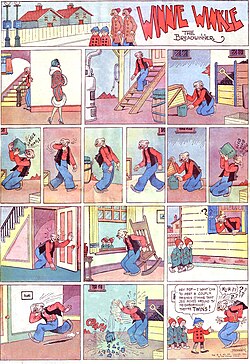| Winnie Winkle | |
|---|---|
 Winnie Winkle Sunday page of March 6, 1927 | |
| Author(s) | Martin Branner (1920–1962) Max Van Bibber (1962–1980) Frank Bolle (1980–1996) |
| Current status/schedule | Concluded |
| Launch date | September 20, 1920 |
| End date | July 28, 1996 |
| Syndicate(s) | Chicago Tribune Syndicate |
| Genre(s) | humor |
Winnie Winkle is an American comic strip published during a 76-year span (1920–1996). Ten film adaptations were also made. Its premise was conceived by Joseph Medill Patterson,[1] but the stories and artwork were by Martin Branner, who wrote the strip for over 40 years. It was one of the first comic strips about working women.[2] The main character was a young woman who had to support her parents and adopted brother, serving as a reflection of the changing role of women in society. It ran in more than 100 newspapers and translations of the strip's Sunday pages were made available in Europe, focusing on her little brother Perry Winkle and his gang.
Due to its originality and longevity, Winnie Winkle became a household name and inspired Roy Lichtenstein.[3] It was reprinted in Dell Comics, and some see it as heralding a more independent role for American women after World War I.[4]
- ^ Time (July 3, 1939). "1,848,320 of Them". Archived from the original on September 30, 2007. Retrieved February 22, 2007.
[Joe Patterson] thought up The Gumps (his mother coined the word), Winnie Winkle the Breadwinner, Dick Tracy
- ^ Drowne, Kathleen Morgan; Huber, Patrick (2004). The 1920s. Greenwood Publishing Group. p. 280. ISBN 978-0-313-32013-2.
And Martin Branner's Winnie Winkle… marked the advent of a number of strips featuring modern wage-earning women
- ^ New York Times (October 8, 1993). "On Top With Pop: A Virtuoso Of Irony". The New York Times. Retrieved February 23, 2007.
- ^ The Seattle Times (April 7, 1996). "New Women Stride In". Retrieved February 23, 2007.
By mid-decade, "Betty" and "Winnie Winkle, The Breadwinner" joined these old stand-bys, celebrating the fun and independence of single young women.